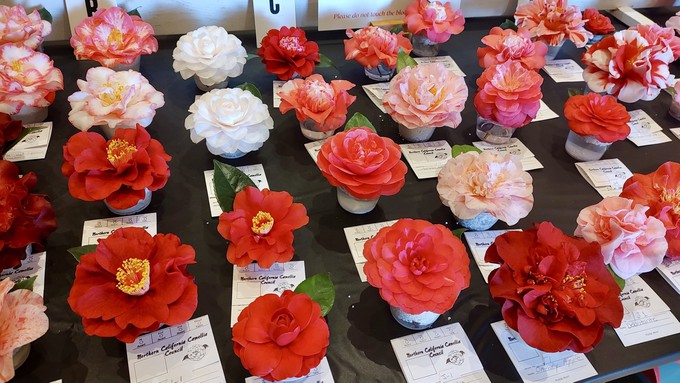
Cold storms remind us: It’s still winter (but we have camellias)

These exquisite camellia blossoms are entries in the 100th Sacramento Camellia Show. The show is open to the public 3 to 6 p.m. today (Saturday) and 10 a.m. to 5 p.m. Sunday at the Scottish Rite Temple in East Sacramento. Debbie Arrington
Following a record warm weekend to end February, March’s first weekend feels downright chilly – and wet.
Get used to it; it’s still winter in Sacramento, for at least a little longer.
On Feb. 24, Sacramento reached 70 degrees; this weekend is expected to be about 20 degrees colder – and more than 10 below average. In addition, a chance of rain is in the forecast for every day through Friday.
According to the National Weather Service, Sacramento can expect several days in the 50s or low 60s with overnight lows hovering around 40 degrees. Average temperatures for this week: High of 65 and low of 44.
Making those temperatures feel colder will be plenty of wind. The weather service issued a high wind advisory for Sacramento and the Valley for Saturday (March 2) with gusts up to 45 mph.
Coupled with soft, wet ground, those wind gusts could topple trees or bring down branches. Keep an eye out for leaning trunks or ground disturbances around a tree’s base, a sign of shifting roots.
What to do on this rainy March weekend? Celebrate Sacramento’s favorite flower at the 100th Sacramento Camellia Show. With hundreds of camellias on display, the show is open free to the public 3 to 6 p.m. Saturday, March 2, and 10 a.m to 5 p.m. Sunday, March 3, at a new location – the Scottish Rite Center, 6151 H St., Sacramento.
* Between showers, pick up fallen camellia blooms; that helps cut down on the spread of blossom blight that prematurely browns petals.
* Feed camellias after they bloom with fertilizer formulated for acid-loving plants.
* Camellias need little pruning. Remove dead wood and shape, if necessary.
* Tread lightly or not at all on wet ground; it compacts soil.
* Avoid digging in wet soil, too; wait until it clumps in your hand but doesn’t feel squishy.
* Note spots in your garden that stay wet after storms; improve drainage with the addition of organic matter such as compost.
* Fertilize roses, annual flowers and berries as spring growth begins to appear.
* If aphids are attracted to new growth, knock them off with a strong spray of water or insecticidal soap. To make your own “bug soap,” use 2 tablespoons liquid soap – not detergent – to 1 quart water in a spray bottle. Shake it up before use. Among the liquid soaps that seem most effective are Dr. Bronner’s Pure-Castile Soaps; try the peppermint scent.
* Pull weeds now! Don’t let them get started. Take a hoe and whack them as soon as they sprout.
* Prune and fertilize spring-flowering shrubs after bloom.
* Cut back and fertilize perennial herbs to encourage new growth.
* Make plans for your summer garden. Once the soil is ready, start adding amendments such as compost.
* Indoors, start seeds for summer favorites such as tomatoes, peppers and squash as well as summer flowers.
Comments
0 comments have been posted.Sacramento Digs Gardening to your inbox.
Sites We Like
Garden Checklist for week of July 21
Your garden needs you!
* Keep your vegetable garden watered, mulched and weeded. Water before 8 a.m. to reduce the chance of fungal infection and to conserve moisture.
* Feed vegetable plants bone meal, rock phosphate or other fertilizers high in phosphate to stimulate more blooms and fruiting. (But wait until daily high temperatures drop out of the 100s.)
* Don’t let tomatoes wilt or dry out completely. Give tomatoes a deep watering two to three times a week.
* Harvest vegetables promptly to encourage plants to produce more. Squash especially tends to grow rapidly in hot weather. Keep an eye on zucchini.
* Pinch back chrysanthemums for bushy plants and more flowers in September.
* Remove spent flowers from roses, daylilies and other bloomers as they finish flowering.
* Pinch off blooms from basil so the plant will grow more leaves.
* Cut back lavender after flowering to promote a second bloom.
* It's not too late to add a splash of color. Plant petunias, snapdragons, zinnias and marigolds.
* From seed, plant corn, pumpkins, radishes, winter squash and sunflowers.